Top 15 Philippine Street Food Business ideas to Launch in 2024
Table of Contents

Filipino street fare is a blend of sweet, sour, spicy, and savory flavors, appealing to diverse tastes. Its presentation is straightforward, often served on sticks, in cups, or bowls, emphasizing the delicious simplicity and convenience of these foods.
Originally confined to bustling city streets and populated by workers and students seeking affordable meals, street food has now transitioned into commercial spaces and even upscale restaurants.
The street food industry, valued at $150 billion globally, has been steadily growing, showing no signs of slowing down. According to a 2024 study by the Department of Trade and Industry, the industry has shown resilience and growth potential, especially in urban areas.
In this article, “Street Food Business ideas in the Philippines” we explore a variety of concepts that have proven successful in the dynamic landscape of street food. From traditional favorites to innovative fusion dishes, the possibilities for a profitable venture are as diverse as the flavors on offer.
- Only 1 Valid ID to Apply
- 0% interest for first loan
- Fast approval in 5 minutes

Street Food Industry in the Philippines
The street food industry in the Philippines is a significant contributor to the Philippine economy. It offers entrepreneurial opportunities for many, especially in urban and tourist areas. With relatively low start-up costs, it’s an accessible venture for small-scale entrepreneurs. The industry also creates jobs, from food preparation and serving to supply chain and logistics, supporting local economies.
In response to the changing world, including the aftermath of the COVID-19 pandemic, Filipino street food vendors have shown remarkable adaptability and resilience. The use of digital platforms for marketing and delivery has increased, allowing vendors to reach a broader customer base. Innovations in food safety and hygiene have also become a priority, enhancing consumer confidence.
Despite its popularity, the industry faces challenges such as regulatory compliance, maintaining food safety standards, and navigating urban space limitations.
However, these challenges also present opportunities for innovation and growth, such as the development of food parks and markets that provide a centralized, hygienic space for vendors.

Benefits of Street Food Business in the Philippines
Street food businesses in the Philippines offer several benefits, not just to the entrepreneurs who run them but also to the local economy, culture, and consumers. Here are some key advantages:
- Low Start-Up Costs: Starting a street food business typically requires a relatively small initial investment compared to other types of food businesses. This affordability makes it accessible for many entrepreneurs, including those with limited capital.
- High Demand: Street food is an integral part of Filipino culture. There is a constant high demand for it, especially in densely populated areas like Manila. This ensures a steady stream of customers.
- Simple Operations: Street food businesses usually have straightforward operations. They often focus on a limited menu, making it easier to manage day-to-day activities compared to full-scale restaurants.
- Flexibility: Vendors have the flexibility to choose strategic locations with high foot traffic, like markets, schools, and commercial areas. They can also easily shift locations if one spot isn’t profitable.
- Quick Turnover: Street food items are typically quick to prepare and serve, leading to a fast turnover of customers and, consequently, quicker returns on investment.
- Low Overhead Costs: Operating a street food business in the Philippines generally incurs lower ongoing expenses than a traditional restaurant. There’s less need for a large staff, extensive equipment, or a large space.
- Scalability: Successful street food businesses can scale up. Owners can expand by adding more carts or kiosks, or even evolve into a brick-and-mortar establishment.
- Community Presence: Street vendors often become well-known figures in their communities, leading to loyal customer bases and word-of-mouth marketing.
Financial Calculations and Benefits:
- Examples: Balut, kwek-kwek, fish balls
- Initial Investment: Approximately PHP 10,000 to 20,000
- Profit Margins: 60-70%
Educate yourself about
How to Get Business loan in the Philippines
TOP 10 Street Food Business Ideas in the Philippines
Philippine street snacks mainly fall into two categories: “inihaw or sugba” (grilled) and “prito or pinirito” (fried). Grilling is deeply embedded in Filipino culture, with a variety of meats typically skewered, grilled over charcoal, basted in barbecue sauce, and served with seasoned vinegar. Grills are a common sight, dotting the urban landscape.
Fried street foods are equally popular, featuring savory items often accompanied by spicy-sweet dipping sauces or seasoned vinegar. Although frying wasn’t originally a staple cooking method in Filipino cuisine, it has become a beloved technique, particularly for street food. Let’s delve into the finest and simplest street food business ideas that the Philippines has to offer.
1. Fish Balls, Squid Balls and Chicken
Fish and squid balls are iconic street foods in the Philippines, enjoyed by locals and visitors alike. These tasty morsels are typically deep-fried and served hot to eager customers who pick their desired amount using skewers.
In the bustling streets, you’ll often find these fish and squid balls sharing the wok space with other delights like kikiam, a snack made from taro, and even brightly colored red hot dogs. After skewering their chosen treats, customers then dip them in a variety of sauces, ranging from sweet, garlic-infused concoctions to simple, spicy vinegar dips.
The humble fish ball is a beloved snack in the Philippines, often evoking nostalgic memories for many who’ve enjoyed it since their school days. Although the basic taste of the fish balls remains similar across different vendors, the unique appeal often lies in the variety of sauces offered. Some vendors pride themselves on their special semi-sweet sauce, while others may boast of a tangy, spicy vinegar blend.
This street food, with its simple yet delicious offerings, continues to hold a special place in the heart of Filipino cuisine. Whether it’s fish, chicken, or squid balls, these snacks are a testament to the country’s love for flavorful, accessible, and unpretentious food. They’re typically served either boiled or fried, often accompanied by the famous Manong’s sauce.
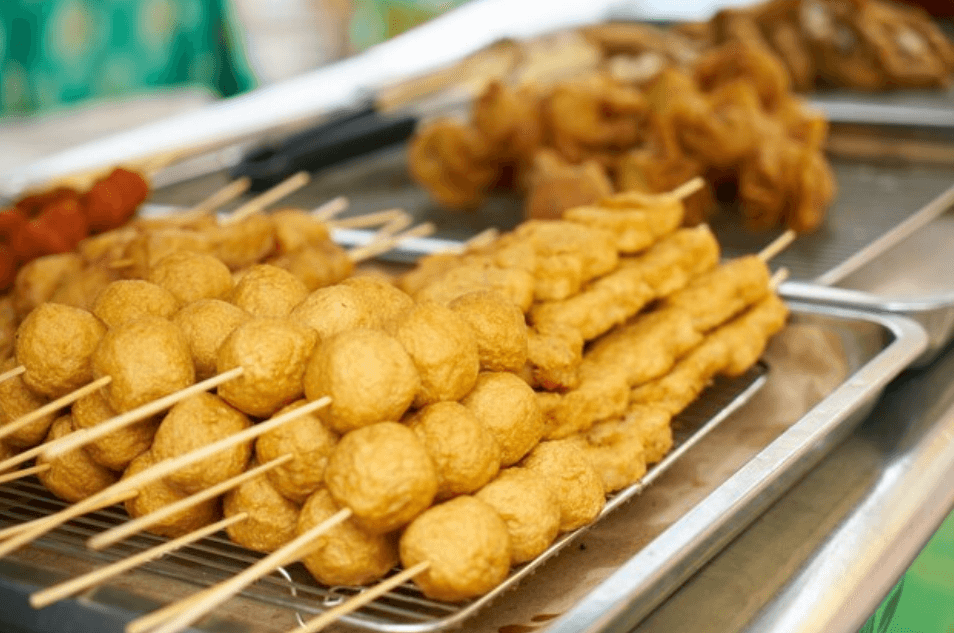
2. Kwek Kwek (Tokneneng)
Kwek Kwek, a renowned street food in the Philippines, is cherished for its simplicity and delightful taste. This dish consists of hard-boiled quail eggs that are coated in a distinctive orange batter made from annatto powder, flour, and water. Once the eggs are enveloped in this colorful batter, they are deep-fried until the exterior is crispy.
This snack is often sold alongside other popular street foods like fish balls, squid balls, chicken balls, cotton candies, kikiam, and calamares. In Manila, Kwek Kwek is sometimes referred to as “tokneneng,” a term used for a similar dish made with chicken or duck eggs.
Kwek Kwek is typically served on skewers or in plastic cups, accompanied by a spiced vinegar-based dip that often includes chopped garlic, onion, chilies, and cucumber. This combination of the soft, flavorful egg and the tangy, spicy dip creates a taste experience that is both unique and familiar to Filipino palates.

3. Balut
This delicacy is a fertilized duck egg that has been incubated for about three weeks, then hard-boiled and typically eaten straight from the shell. As a street food staple, Balut can be found everywhere from casual street stalls to more upscale restaurants across the Philippines.
Introduced to the Philippines by the Chinese around the 16th to 19th century, Balut has since become an integral part of Filipino culture. It is not only a common sight on the streets but also a relatively affordable source of protein and calcium, making it both a nutritional and cultural fixture. Nutritionally, Balut is quite comparable to a chicken egg, boasting 7 grams of protein, negligible trans fat, and only 1 gram of carbohydrates. With approximately 80 calories per egg, consuming two can constitute a complete meal. Many enjoy the taste of Balut enhanced with a dash of vinegar or a pinch of salt.
In recent times, Balut has found its way into the menus of fine dining restaurants. The egg is now often minced and sautéed in olive oil, infused with flavors from garlic, onions, capers, pepper flakes, salt, and a squeeze of lemon juice. This gourmet version of Balut is typically served with toasted bread, offering a sophisticated twist on a classic Filipino delicacy.
While Balut is most prevalent in the Philippines, it is also a well-known street food in other Southeast Asian countries like Vietnam and Cambodia. Its unique taste and preparation have made it a celebrated delicacy in these regions. In addition to its culinary appeal, Balut is often considered an aphrodisiac and is commonly enjoyed with a cold beer on the side.
The consumption of Balut can evoke mixed reactions: while it is a beloved snack for many locals and adventurous tourists, others may find it less appealing. For those less inclined to try Balut, there’s an alternative called Penoy, which is similar but doesn’t contain the duck embryo, offering just the gooey egg yolk.

4. Isaw
Isaw, a beloved street food in the Philippines, is known for its distinctive preparation and rich flavor. This dish consists of chicken or pork intestines, which are meticulously cleaned, marinated, boiled until tender, and then grilled. The marinade typically includes soy sauce, oil, ketchup, garlic, and other seasonings, infusing the intestines with a savory depth of flavor.
While both chicken and pork intestines are used, pork isaw is noted for being slightly larger and chewier than its chicken counterpart. After the boiling process, the intestines are usually skewered on sticks and grilled to perfection. For added appeal and flavor, some vendors apply an orange food coloring to the intestines and often use a basting sauce during grilling. This adds to the visual allure and enhances the taste of the dish.
Isaw is not only a popular snack enjoyed on its own but also pairs well with beer or liquor, making it a common choice for social gatherings and casual dining. It can also be served with rice for a more substantial meal.
The popularity of Isaw lies in its combination of simple ingredients and traditional cooking methods, creating a dish that is both comforting and distinctly Filipino.
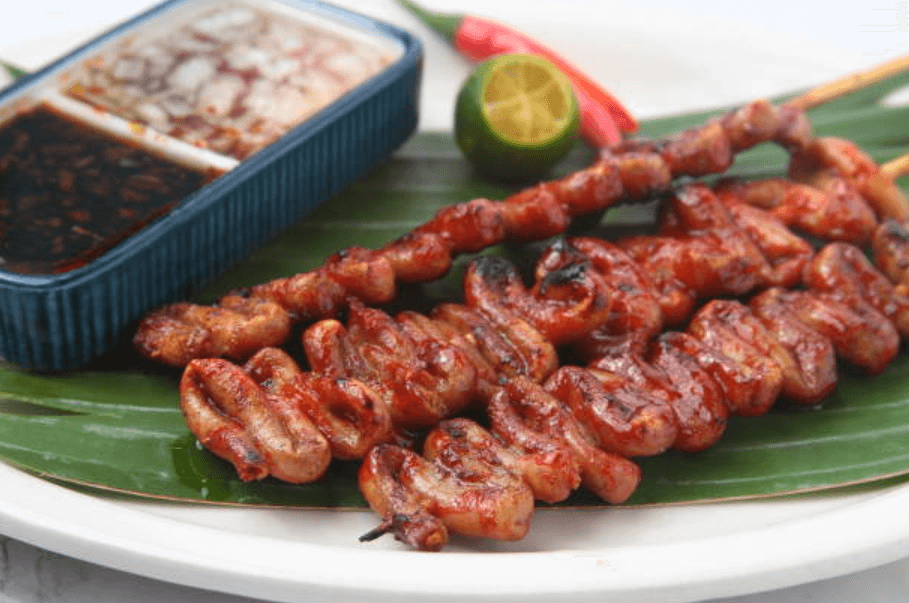
5. Laman Loob
In the bustling street food scene of the Philippines, “Laman Loob,” a term encompassing various internal organs, is celebrated for its rich flavors and unique textures. This culinary practice involves grilling a diverse range of offal, from chicken gizzards, livers, and hearts to pig’s ears, butts, and even heads. Each of these items is lovingly basted with a special marinade or barbecue sauce that infuses them with delectable flavors. After grilling to perfection, they are typically served with spiced vinegar, which adds a tangy contrast to the savory, smoky taste of the grilled offal.
Isaw stands out as a prominent example of offal-based street food.
Proben, another popular offal dish. It’s made from a chicken organ called the proventriculus, akin to a gizzard, and is known for its crispy texture. The organ is typically coated in flour or cornstarch and then deep-fried, resulting in a crunchy and satisfying street food item.
Additionally, other offal dishes like Bopis and Papaitan have also gained acclaim. Bopis, which uses the heart and lungs of beef or pork, is stewed or sautéed with a variety of vegetables and spices, and often accompanied by beer or other alcoholic beverages. Papaitan, on the other hand, is a soup made with goat or cow innards like heart, tripe, and liver. The distinctiveness of Papaitan comes from the bile (papait), which imparts a unique bitterness and a yellow-green color to the dish.
Aside from these well-known dishes, Laman Loob encompasses a broader range of grilled offal such as chicken gizzard, liver, heart, pig’s ears, butt, and even heads.

6. Siomai
Siomai, a delightful street food in the Philippines, is widely regarded as one of the tastiest and most popular dishes in the country. These small meat dumplings, known for their lightness and flavorful filling, are a testament to the influence of Chinese cuisine on Filipino culinary traditions.
The typical Siomai is a Filipino-style dumpling filled with a variety of ingredients such as ground beef, mushrooms, and vegetables, or with ground pork, shrimp, and shiitake mushrooms. These ingredients come together to create a snack that is not only tasty but also filling, making Siomai a versatile dish suitable as an appetizer, snack, or even a main meal.
Originally a traditional Chinese dumpling, Siomai has seamlessly integrated into Filipino culture, becoming a beloved staple. Its widespread popularity is evident in the numerous stalls, eateries, and restaurants across the Philippines that serve this dish. While traditionally steamed, Siomai can also be found in fried variations, often accompanied by soy sauce and calamansi, a type of local citrus, to enhance its flavors.
Siomai’s affordability and convenience make it particularly popular among students and working-class adults. Its presence ranges from humble street food stalls to high-end restaurants, highlighting its universal appeal and adaptability to different dining contexts.

7. Helmet, Adidas, And Betamax/DVD
In the vibrant streets of the Philippines, an array of unique and intriguing street foods captivate the senses. Among these, “Helmet,” “Adidas,” and “Betamax” stand out for their distinctiveness and local popularity.
- Helmet: This dish, humorously named after the protective headgear, is actually made from chicken heads. In the Philippines, no part of the chicken goes to waste. Chicken heads, known as “Helmet,” are a testament to this sustainable approach. The heads are usually grilled or fried, offering a crispy and flavorful experience. This dish is not only a treat for the taste buds but also a reflection of the Filipino ethos of resourcefulness and respect for food.
- Adidas: Similarly, “Adidas” derives its name from the famous shoe brand, but in the culinary streets of the Philippines, it refers to grilled chicken feet. The three toes of the chicken feet resemble the iconic three stripes of the Adidas logo, hence the playful name. These chicken feet, while not meaty, are prized for their rich, fatty skin that turns irresistibly flavorful and crispy when grilled. This dish showcases the Filipino culinary art of transforming simple ingredients into a mouthwatering delight.
- Betamax and DVD: “Betamax” and its variant, “DVD,” are not about retro technology but rather about a unique way of enjoying coagulated chicken blood. Originally shaped like the rectangular Betamax video cassettes, these blood cakes are skewered and grilled. The name evolved to “DVD” or “VCD” when their shape changed to round pucks, resembling modern video discs. These blood cakes, far from being a mere curiosity, are a delicacy with a rich flavor and unique texture, offering a different experience from the usual barbecue meats.
Each of these dishes, with their quirky names and delicious flavors, embodies the creativity and culinary diversity of the Philippines. They are not just street food; they are a window into the culture and the ingenious spirit of Filipino cuisine.

8. Beef or Chicken Pares
Beef or Chicken Pares, a popular Filipino street food, is a common sight bustling with customers, especially around meal times. The word “Pares” translates to “pair,” a concept deeply rooted in Filipino-Chinese culinary traditions.
This delightful meal typically consists of a savory noodle soup with either beef or chicken, complemented by “Siopao,” a cherished Chinese-inspired bun filled with meat, and traditionally steamed. Enhancing the soup with a splash of soy sauce and a squeeze of calamansi or local lemon juice elevates the flavors. This combination offers a satisfying and economical option for lunch or dinner.
Some Pares vendors also offer “Lugaw,” a comforting rice porridge, and “Cuapao,” a unique take on Siopao featuring succulent pork belly and garnished with nuts.
The secret to a captivating Pares lies in its broth. Many stall owners guard their broth recipes closely. These recipes often involve a rich base made from a blend of chicken, pork, and fish bones, infused with a secret mix of spices and seasonings, giving each Pares its unique and irresistible flavor.
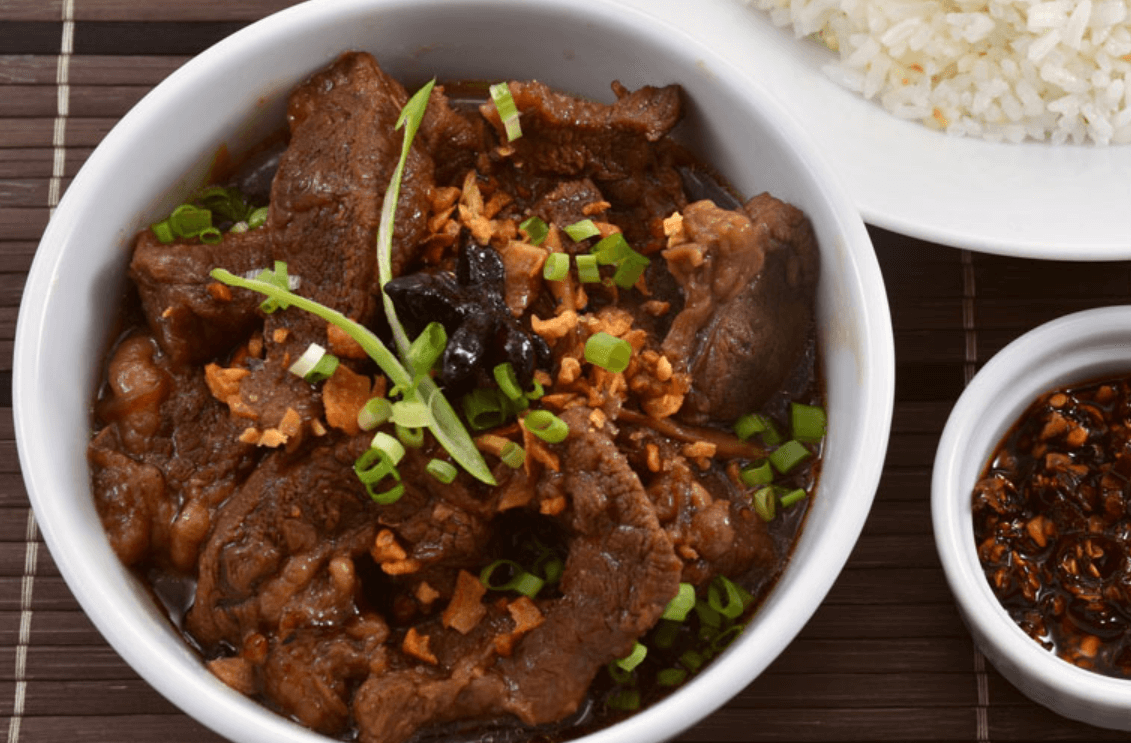
9. Tapsilog
This dish is a clever blend of “tapa” (marinated beef), “sinangag” (fried rice), and “itlog” (egg). Variations abound, like “longsilog,” which swaps tapa with “longanisa” (sausage).
This dish is a variation of the “silog” family, where garlic fried rice and fried egg are staples, paired with different proteins. Examples include tosilog (with pork), bangsilog (fish), and Spamsilog (with Spam), showcasing the versatility and creativity of Filipino cuisine. Each variant offers a unique taste experience, making silog dishes a popular choice for a hearty and flavorful meal.
To elevate the experience, pairing it with chilled, fresh dalandan juice creates a harmonious blend of flavors. Besides tapsilog, inventive variants include “tuyo” (dried anchovies), pork belly, and Chinese sausage, showcasing the creativity and exceptional value of Filipino street food.
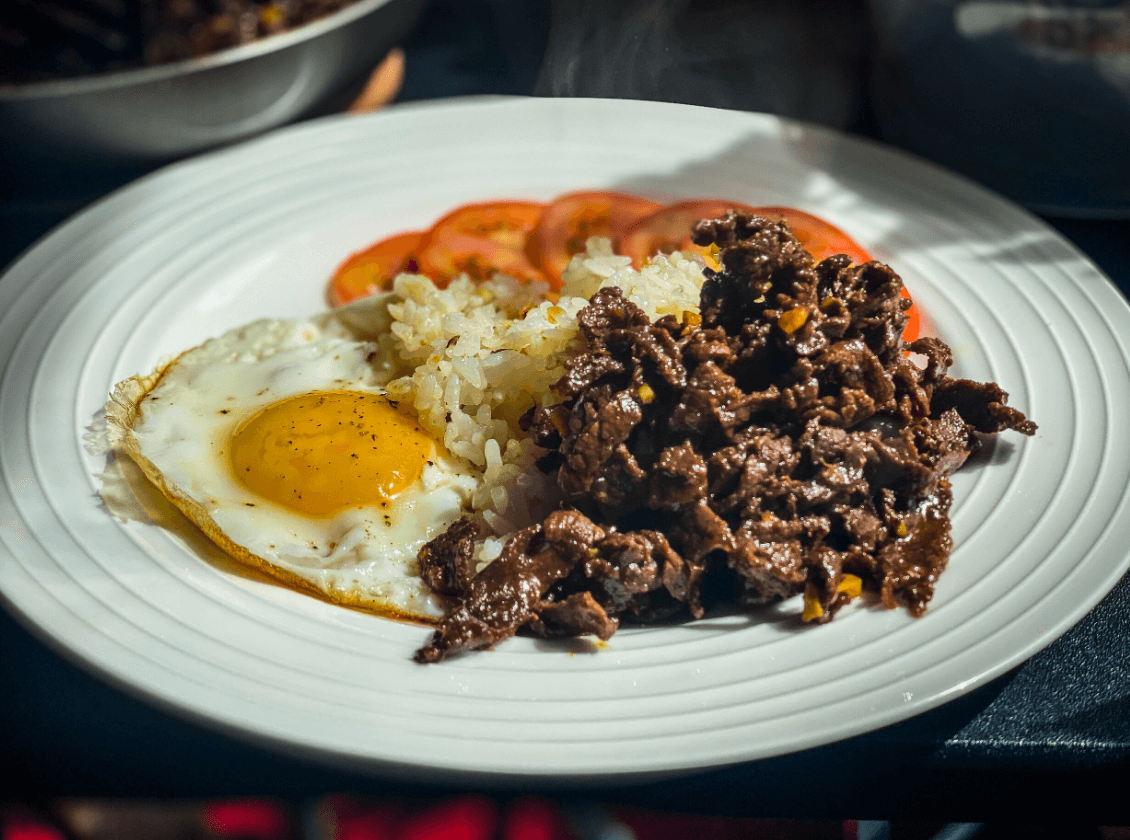
10. Ukoy
Ukoy, a classic Filipino street food, is a savory delight enjoyed throughout the Philippines. These crispy deep-fried fritters are made with a batter of glutinous rice, which is combined with unshelled small shrimp and a variety of vegetables, such as calabaza (a type of squash), sweet potato, cassava, mung bean sprouts, scallions, julienned carrots, onions, and green papaya. The fritters are traditionally dyed bright orange with achuete seeds, giving them a distinct and vibrant appearance.
Ukoy offers a range of variations, with some recipes replacing shrimp with small fish or calamari. The batter can be made from different ingredients, including regular flour, rice flour, or a mixture of egg and cornstarch. Some versions of Ukoy are more akin to omelets, made with mashed calabaza or sweet potato, with or without shrimp.
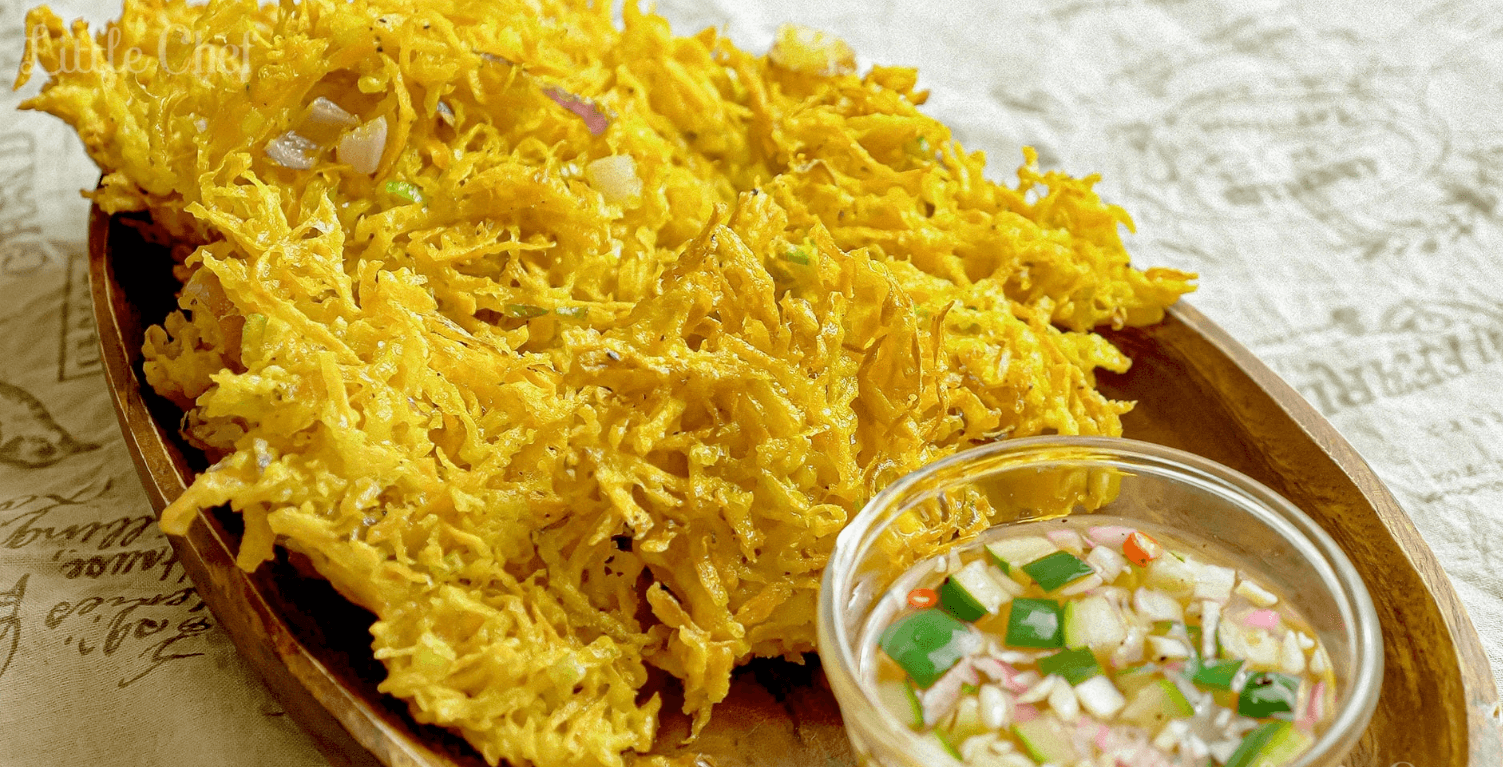
The name ‘Okoy,’ as it is sometimes called, has its origins in the Hokkien phrase ō+kuè, meaning “cake made from taro.” However, the Filipino Ukoy is quite different from its Hokkien counterpart, which is made from deep-fried taro and minced pork. The main similarity between the two is their deep-fried, pancake-shaped form.
Traditionally, the most basic Ukoy recipe uses a small amount of galapong (ground soaked glutinous rice) for the batter, which is spiced with onion, garlic, salt, and scallions. This mixture is combined with mashed kalabasa and unshelled small shrimp, then deep-fried into small flat patties until golden brown. Other ingredients like kamote (sweet potato), kamoteng kahoy (cassava), mung bean sprouts, and green papaya can also be added. The fritters are served warm and crispy, usually with a vinegar-based dipping sauce, which may include various combinations of chilis, ginger, garlic, peppercorns, and onion. Other dipping options include banana ketchup, tomato ketchup, sweet and sour sauces, or even garlic mayonnaise.
Ukoy is enjoyed as a snack, appetizer, or even as a breakfast meal, showcasing the versatility and popularity of this Filipino culinary staple.

Need extra money for your business? Show 1 valid ID and get an online loan today! Calculate your pre-approved loan amount with Digido’s calculator:
* Interest payments are approximate. The final loan amount and interest rate must be confirmed in your loan agreement after loan approval.
5 Sweet Dessert Street Food Business ideas in the Philippines
When delving into the world of sweet dessert street food in the Philippines, there are several key facts that budding entrepreneurs should consider:
- Abundance of Local Fruits: The Philippines is rich in a variety of tropical fruits like mangoes, bananas, and coconuts. These fruits not only provide a fresh and abundant source of ingredients but also appeal to customers looking for natural and locally-sourced options.
- Cost-Effectiveness: Many Filipino dessert recipes are cost-effective, utilizing simple, affordable ingredients. This aspect is particularly attractive to entrepreneurs who are starting with limited capital.
- Cultural Appeal: Filipino desserts have a unique cultural appeal, often tied to local festivals and traditions. This aspect can be a unique selling point, especially in areas with significant cultural tourism.
- Social Media Friendliness: Colorful and unique desserts are highly shareable on social media platforms, offering free marketing opportunities.
- Year-Round Demand: Unlike some seasonal businesses, dessert offerings can be adapted to be suitable year-round, ensuring a consistent customer base.
Let’s explore the most popular and easy-to-make street food desserts in the Philippines.
1. Banana Cue
Banana Cue, a beloved street food in the Philippines, is crafted from saba bananas, which are deep-fried in margarine and coated with caramelized sugar. This method of preparation not only tenderizes and sweetens the bananas but also creates a delicate candy-like coating around them. This coating adds a delightful texture, reminiscent of bananas foster but with an enhanced, more appealing texture. The bananas are then skewered on sticks, making them an easy-to-eat, on-the-go treat that combines the natural sweetness of the fruit with the rich, caramelized flavor of the sugar. This combination of flavors and textures makes Banana Cue a unique and popular choice among Filipino street foods, offering a simple yet indulgent culinary experience.
Widely beloved throughout the Philippines, banana cue is often enjoyed as an afternoon snack or served as a dessert. Its widespread popularity is due in part to the availability and affordability of bananas in the country, making it an accessible sweet treat for many. Banana cue’s easy preparation and delicious taste have earned it a place as one of the all-time best-selling street foods in the Philippines, beloved by locals and tourists alike.

2. Halo-Halo
Halo-Halo, a beloved Filipino dessert and a popular street food, is a colorful and refreshing treat that perfectly encapsulates the diversity and vibrancy of Filipino culinary culture. The name “Halo-Halo” translates to “mix-mix” in English, reflecting the dessert’s assortment of ingredients that are mixed together to create a delightful symphony of flavors and textures.
The origins of Halo-Halo can be traced back to the influence of Japanese cuisine, particularly the Japanese dessert kakigori, which is a type of shaved ice sweetened with condensed milk, syrup, and sweeteners. Filipino Halo-Halo evolved from the Japanese mitsumame, a dessert made of crushed ice with various ingredients like red beans, sweetened with sugar and milk. When Japanese immigrants brought kakigori to the Philippines, they adapted it to local tastes by adding ingredients like mongo, red and kidney beans, and even papaya.
Filipino Halo-Halo is made with a base of sweetened beans, fruits, and root crops such as monggo, bananas, jackfruit, sweet potatoes, ube, nata de coco, and young coconut. It is then topped with shaved ice, milk, Leche flan, and ice cream. Commonly, Halo-Halo is finished off with a sprinkle of crispy pinipig or pounded rice for extra crunch. This combination results in a treat that offers creamy, soft, and chewy sensations, making each spoonful an exciting experience.
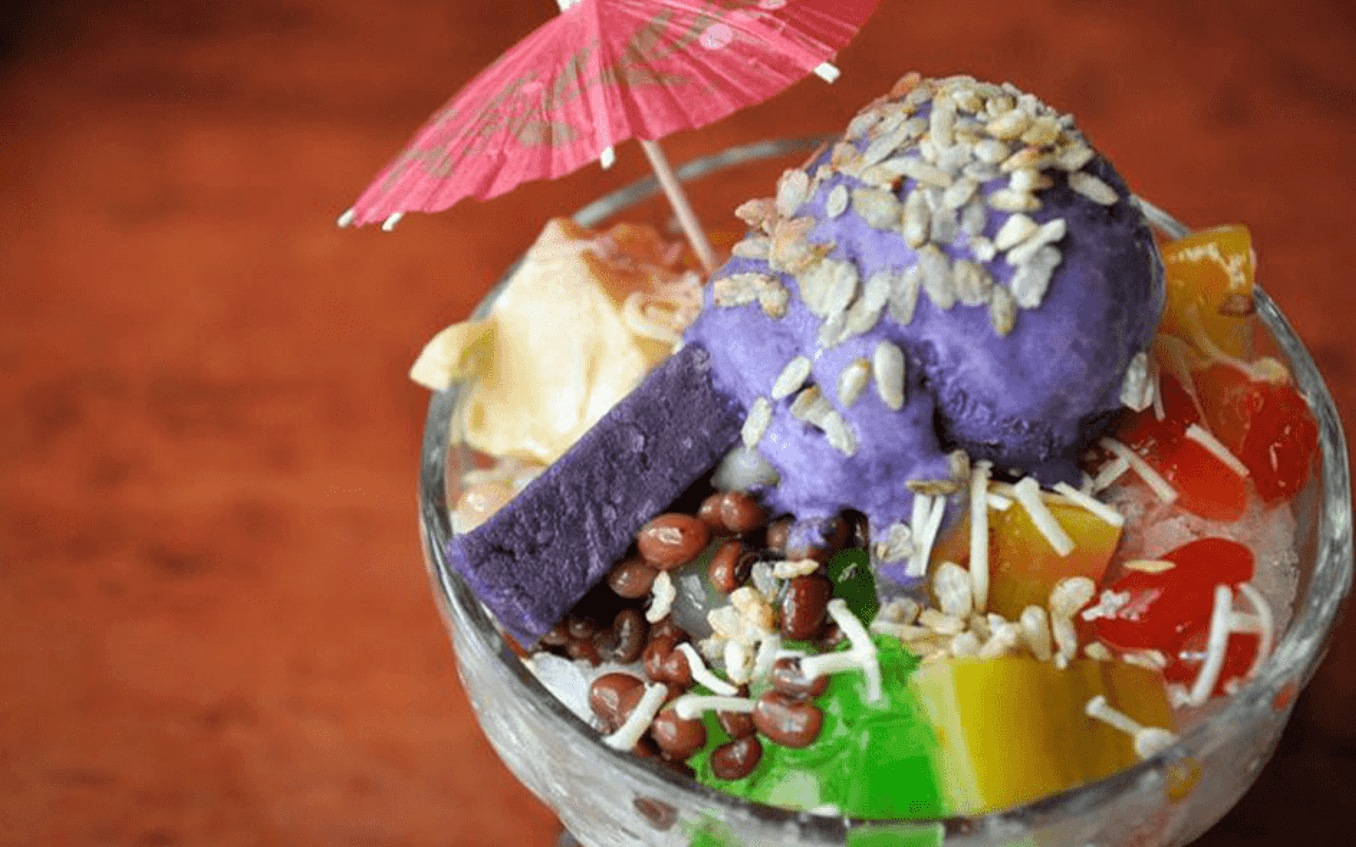
The dessert is highly customizable and can include a wide range of components such as coconut gel, sugar palms, sweetened jackfruit, saba bananas, ripe Manila mango slices, sweetened sweet potatoes, various types of sweetened beans, sweet corn kernels, gulaman (jelly), tapioca pearls, young coconut, evaporated or fresh milk, pinipig, purple yam jam (ube halaya), Leche flan, and different flavors of ice cream.
During World War II, when the Japanese residents were repatriated following their country’s defeat, the tradition of making what was then known as “mongo-ya” almost disappeared. However, Filipino entrepreneurs preserved and further developed this dessert, leading to the modern Halo-Halo known and loved today.

3. Dirty Ice Cream
Many Filipino adults recall fond childhood memories of enjoying this light, refreshing dessert with their parents. Traditional flavors include Cheese, Chocolate, and Ube (Purple Yam), with an innovative twist seen in the Ice Cream Sandwich, where various flavors are packed into soft, freshly baked buns.
The name “Dirty Ice Cream” originated from the sight of the “Sorbetero,” or ice cream vendor, serving ice cream into cones without gloves, creating a certain perception.
There’s potential for more distinctly Filipino flavors, such as Avocado, Cashew and Langka, Buko Macapuno, and Mantecado. Additionally, milkshakes made from fresh carabao or goat’s milk could add an exciting dimension.
Interestingly, the full flavor of ice cream is often missed due to the cold numbing our taste receptors. A friend once recommended heating Ube ice cream slightly in the microwave, which dramatically intensified its flavor. This idea gives rise to the concept of “Dirty Ice Cream Soup,” served with Otap for dunking, a potentially groundbreaking street food innovation in the Philippines.
Sorbetes, as it’s commonly known, or dirty ice cream, isn’t actually dirty; it’s a playful term reflecting its street-side origins. Made from carabao milk, it’s sold in carts where tubs are kept cold with ice and salt, served in small portions in sugar or wafer cones, all at an affordable price, often under PHP 50.
The earnings from selling Dirty Ice Cream in the Philippines depend on several factors, including location, selling price, volume of sales, and expenses. Here are some key aspects:
- Location: Vendors operating in popular tourist spots or busy urban areas can expect a higher footfall compared to those in less crowded locations.
- Seasonality: Demand for ice cream increases during warmer months, which can lead to an increase in sales.
- On average: a small ice cream vendor can earn from a few hundred to several thousand pesos per day, depending on the above factors. However, this is an approximate estimation, and actual income can vary.

4. Turon
Turon, also known as lumpiang saging or banana lumpia, is a beloved street food in the Philippines, celebrated for its sweet and crispy characteristics. This delectable snack is made from thinly sliced bananas, typically saba or Cardaba bananas, which are rolled in spring roll wrappers. The bananas are then fried until the wrapper becomes crispy and golden, and are often coated with caramelized brown sugar for a deliciously sweet finish.
A classic Filipino treat, Turon is not only popular as a street food but is also easy to make at home. The preparation involves wrapping ripened bananas in spring roll wrappers, creating a light and crispy snack. To add a tropical twist, thin strips of jackfruit are often included in the wrap, enhancing the flavor and texture of the Turon.
Regarded as one of the most popular snacks in the Philippines, Turon serves as a perfect midday snack or a delightful dessert after a meal.

5. Taho
Taho, a beloved Filipino snack, is a delightful combination of soft, silken tofu, sago pearls (similar to tapioca pearls), and a sweet, viscous syrup called arnibal. This comfort food has its roots in the Hokkien dish “tāu-hū,” introduced to the Philippines by Hokkien immigrants. It has since become a staple across the country, enjoyed as a vegan soy dessert traditionally savored for breakfast or as an energizing treat any time of the day.
The preparation of Taho is an art in itself. Vendors, known as Mágtatahô, begin their day before dawn, carefully processing the silken tofu to a custard-like consistency. The brown sugar is caramelized and mixed with water, sometimes flavored with vanilla, to create the amber-colored arnibal syrup. Meanwhile, the sago pearls are boiled until they reach a gummy, translucent state. While some vendors may prepare the soft tofu from scratch, store-bought soft tofu mix can also be used.
The Mágtatahô is a familiar sight on Philippine streets, typically carrying two large aluminum buckets on a carrying pole. One bucket holds the tofu base, and the other contains the arnibal, sago pearls, and cash. They peddle their product in a unique manner, walking at a leisurely pace and calling out “Tahô!” in a loud, rising tone to attract customers. Though primarily seen in the mornings, it’s not uncommon for vendors to work in the late afternoon or evening as well.
Taho is usually served warm and enjoyed with a spoon, sipped through a straw, or slurped straight from the cup. Cold versions of Taho are also available in supermarkets and food stalls, typically featuring firmer tofu and served in pre-packed cups with a plastic spoon or wooden stick.
This simple yet delightful snack, with its soft tofu, chewy sago pearls, and sweet syrup, not only offers a taste of traditional Filipino flavors but also reflects the country’s rich cultural heritage and culinary ingenuity.

What is the Most in Demand for Street Food in the Philippines?
The demand for street food in the Philippines is high, characterized by a diverse range of popular and affordable options that cater to both locals and tourists. Some of the most demanded street foods include:
| Rank | Street Food | Description |
|---|---|---|
| 1 | Balut | A fertilized duck egg with a nearly-developed embryo inside, boiled and eaten from the shell. Known for its distinct taste. |
| 2 | Pancit | A noodle dish with various toppings like meat and vegetables, symbolizing long life and often served at birthdays. |
| 3 | Halo-halo | A cold dessert consisting of a mix of ingredients like beans, fruits, shaved ice, and milk, topped with ice cream or leche flan. |
| 4 | Fish Balls | Fried or boiled fish balls served on skewers, commonly dipped in a variety of sauces. |
| 5 | Kwek-Kwek | Hard-boiled quail eggs coated in an orange batter and deep-fried, typically served with a vinegar-based sauce. |
| 6 | Taho | A sweet snack made with soft tofu, arnibal (sweet syrup), and sago pearls. Often served warm in cups. |
| 7 | Isaw | Grilled chicken or pork intestines, cleaned and skewered, commonly served with vinegar dipping sauce. |
| 8 | Manggang Hilaw | Green mangoes sliced and served with bagoong (shrimp paste), salt, or sugar. It’s known for its sour and tangy taste. |
10 Key Tips for Success in opening a Street Food Business

- Research Local Street Food Scene: Understand the popular street foods, competition, and demand in your area. This helps in developing a menu that caters to local tastes and stands out from competitors.
- Develop a Catered Menu: Create a menu with popular local street food items, adding unique twists to make your offerings distinctive. Keep the menu simple, versatile, and affordable.
- Secure Necessary Permits and Licenses: Obtain all required permits, such as food handler’s, business, and sanitation permits. Compliance with local regulations is crucial for legal operation.
- Invest in Quality Equipment: Purchase essential equipment like a food cart, cooking devices, utensils, and other supplies. Ensure they meet safety standards and are suitable for your needs.
- Create a Detailed Business Plan: Develop a comprehensive business plan with clear financial projections. This will guide your business strategy and can assist in securing funding or investors.
- Choose a Strategic Location: Select a high-traffic, visible location that complies with local regulations. Consider factors like foot traffic, competition, and rental costs.
- Develop a Strong Marketing Strategy: Utilize social media, flyers, and local events to promote your business. Building a robust online presence on platforms like Instagram and Facebook can attract a wider audience.
- Establish a Strong Brand Identity: Create a memorable brand and logo. Consistently use your branding across all platforms, including your food cart, packaging, and digital presence.
- Prioritize Food Safety: Implement a food safety plan and ensure all staff are trained in food handling and safety procedures. Regularly update and review your safety protocols.
- Evaluate and Adapt: Continuously assess your business performance and make necessary adjustments. Stay responsive to customer feedback, market trends, and operational efficiency.
Additional Marketing Tips:
- Network with other street food vendors, food bloggers, and local influencers to build a strong reputation.
- Be active in the community, participate in local events, and ensure your food is accessible.
- Implement a loyalty program to encourage repeat business.
- Leverage various online platforms for wider reach and engagement with customers.

FAQ
-
What permits are necessary for running a street food business Philippines?You need a food handler's permit, business permit, sanitation permit, Mayor's permit, Barangay clearance, and BIR registration.
-
What equipment is essential for starting a pinoy street food business?A food cart, cooking equipment, utensils, food storage, and preparation equipment are crucial.
-
What should be considered when choosing a location for a street food business in Philippines?High foot traffic areas, visibility, local regulations, cost, and accessibility are key factors.
-
How can a street food business attract customers?Through social media, flyers, participating in local events, and building a strong online and community presence.
-
How should a menu be developed for a street food business in the Philippines?The menu should include popular local street foods, with a unique twist, keeping it simple, varied, and affordable.
Authors
Digido Reviews
-
S. AntonyI had a passion for a pinoy street food business, but traditional banks rejected my loan applications due to my bad credit history. Fortunately, I discovered Digido, a legitimate financial service provider in the Philippines. Even though I was unemployed, Digido approved my loan request and provided me with the financial support I needed to kickstart my street food business idea. All the process was online and took just 10 minutes to get the money in my bank account!5
-
AngelaStarting a street food business was my dream, but I needed financial support because my family was facing a shortage of funds. I discovered Digido online because they offer a 0% interest rate for first-time borrowers and require only one ID. Thanks to Digido, I could secure the funds on the same day!5
-
Luis J.The street food industry in the Philippines has always been a part of our family business, and I decided that I wanted to open my own as well. I had everything planned out and began searching for investments and where to obtain them. I learned about short-term loans. If you don't have the necessary capital, for instance, you can turn to Digido. They offer loans with 0% interest, and you can access up to 25,000 PHP in only 4 minutes! This is an excellent way to kickstart your street food venture without significant upfront costs.5


